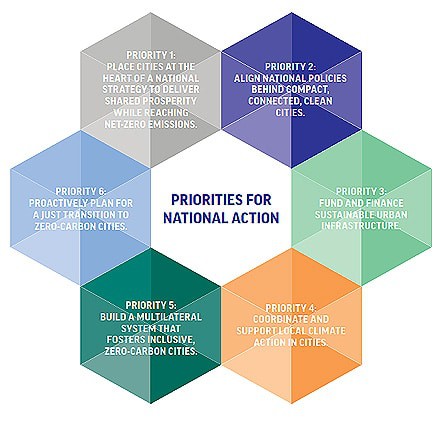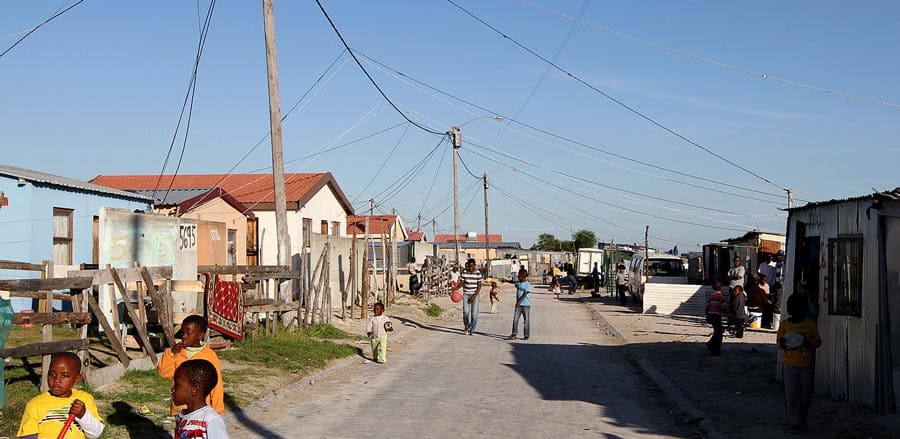In the Face of an Urban Climate Emergency, Collaborate!
Cities and Climate Change are Intrinsically Linked
Cities account for an estimated 76 per cent of greenhouse gas (GHG) emissions. And even though urbanisation has levelled off in the Americas and Europe, Asia and Africa are on track to add 2.25 billion people to cities by 2050, accounting for 90 per cent of total urban growth over the next 30 years. Without immediate action, these expanding cities will be locked into high-emission trajectories for decades to come.
Urban dwellers are particularly vulnerable to the effects of climate change. Over the next three decades, 1.6 billion urban residents will face increasingly lethal heat waves on a regular basis; and new research estimates that 150 million people are currently living on land that will be underwater by 2050.
We must fundamentally shift how we build, design, and live in cities in order to increase urban resilience and limit global warming to 1.5 degrees Celsius in line with the Paris Agreement.
Here’s the Good News
We already know how to reduce urban GHG emissions by 90 per cent by the year 2050 using existing technology and straightforward mitigation measures. That is according to the flagship report by the Coalition for Urban Transitions (CUT). Offering a vision of sustainable, compact, walkable cities with reduced inequality, increased air quality, and a plethora of accessible green space, CUT lays out six priorities for national action:

Source: Climate Emergency, Urban Opportunity: How national governments can secure economic prosperity and avert climate catastrophe by transforming cities.
Cities need to be at the Centre of National Development Plans
The report focusses on national policy because, despite the growing political role of cities in the global economy, few city halls have authority over energy grids, fuel and energy efficiency standards, and the array of tax, housing, and labour regulations that shape the built environment and the profile of urban GHG emissions.
Moreover, most cities depend on national fiscal transfers and funding schemes to invest in large-scale infrastructure, for which there is a yearly global finance deficit of one trillion US dollars, much of that in and around cities. This is especially true for smaller and medium-sized cities, which are home to half the global urban population and growing faster than large and mega cities.
Who is Responsible for Reducing Urban Emissions?
Of the total emission reduction opportunities, the CUT report estimates that 35 per cent depend on national government authority, 28 per cent on municipal authority, and the remaining 37 per cent require complimenting policies and actions between the local, national and/or regional levels (this calculation excludes emission reductions that come from decarbonising the energy grid, equal to 50 per cent of abatement potential).
This might be the first attempt to quantify global mitigation scenarios based on the administrative authority of the different governing levels. The breakdown is indicative, varies by country, and needs further expert review. Nonetheless, the report puts numbers behind a growing consensus that collaborative climate action is the only way to achieve the goals set out in the Paris Agreement.
Collaborative Climate Action is Imperative for Success
There has been a paradigm shift in research on and practice of climate change governance from strict top-down thinking towards collaborative approaches (often referred to as multi-level or polycentric governance in the literature). Largely driven by disenchantment with the international climate negotiation regime and a groundswell of local climate actions, advocates and experts agree that. a whole-government (indeed a whole-society) approach is the only way to effectively address a rapidly changing climate.
Collaborative climate action includes peer-exchange between cities and multi-stakeholder partnerships with the private sector and civil society. It refers to horizontal policy and governance initiatives that facilitate cooperation between different sectors, for example when energy and housing authorities work together to install solar panels on housing developments.
It also refers to vertical coordination between different governing levels, for example when national governments set up financing schemes to fund community-led adaptation and economic resiliency initiatives.
Breaking Down Silos: An Example from Mexico
A good example of successful horizontal collaboration is Mexico’s coordination of energy and climate policy.
In 2015, Mexico’s government promulgated the Energy Transition Law to establish a framework for renewable energy generation and set standards and targets for GHG emissions. Prior liberalisation of the market, initiated in 2013, had created opportunities for renewable energy innovation.

© Heiner von Lüpke
Climate policy advocates seized the opportunity and pushed for more climate policy in the energy sector, resulting in renewable energy targets and the complete overhaul of energy efficiency regulations. This led to a boom in private investment that tripled the capacity of renewable energy production from 15,138 megawatt in 2018 to 47,384 megawatt in 2019.
A closer look at the process reveals the importance of coherence between political will (policy objectives) and public administration. Implementing Mexico’s ambitions requires greater cross-sector collaboration between the energy and climate policy fields so that their separate budgets, initiatives, and responsibilities are integrated and work towards common objectives. For instance, better inclusion of climate policy makers during the energy planning process could ensure alignment between renewable energy expansion and national climate targets.
Aligning National Policy to the Needs of Local Communities: An Example from South Africa
When it comes to decarbonising energy consumption, South African cities have one hand tied behind their back. Municipal governments are mandated to deliver energy to residents, but they have no authority over the supply chain. Rather, local governments resell electricity bought from the national energy provider, Eskom, which in 2018 relied on coal for 84.3 per cent of generated electricity. No wonder South Africa is the world’s fourteenth largest greenhouse gas emitter.

Cape Town view © Romain Pontida (flickr) (CC-BY-SA 2.0)
Local governments rely on electricity sales for revenue, but more residents are installing their own embedded renewable energy systems that are more reliable and cost-effective. This presents a challenge to the business model on which local service provision relies.
National leadership is lacking.
In 2019, Pretoria updated the National Integrated Resource Plan. The plan temporarily lifts caps on locally embedded power generation and aims to decrease reliance on coal to 60 per cent of the electricity matrix by 2030. That is still too high, argue climate advocates. To address the climate crisis and shore up local revenue streams, the South African Local Governments Association and energy experts say that cities need greater authority to purchase and produce their own clean, renewable energy at scale.

Mfuleni township power lines © ValerioVeo/flickr (CC-BY-NC 2.0)
Urban transformation in South Africa will require national policy that enables local government to transition from coal-dependent revenue streams to the delivery of reliable and renewable energy to all residents.
Bold Action is Needed
We need bold urban action to reduce emissions and stave off the most dangerous effects of climate change. International initiatives such as the Partnership for Collaborative Climate Action continue driving the issue on the global agenda, and advocacy networks are calling for the next annual UN climate change conference to be the ‘multilevel action COP.’
Experience from municipal and national governments shows that purposeful and effective involvement of different stakeholders is necessary to raise ambitions, scale up action, and implement national climate strategies for climate-smart, resilient and liveable cities.
